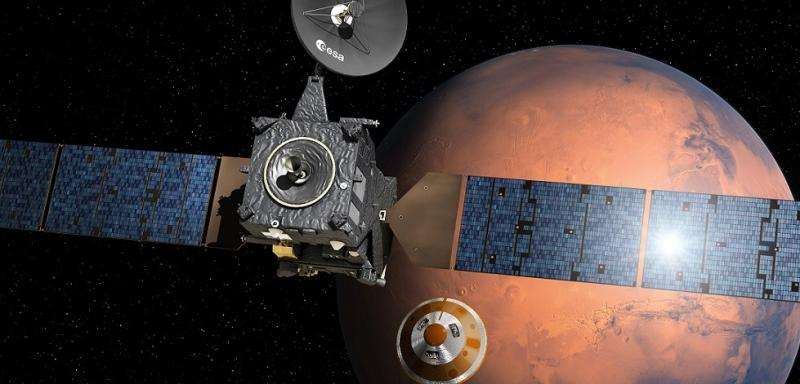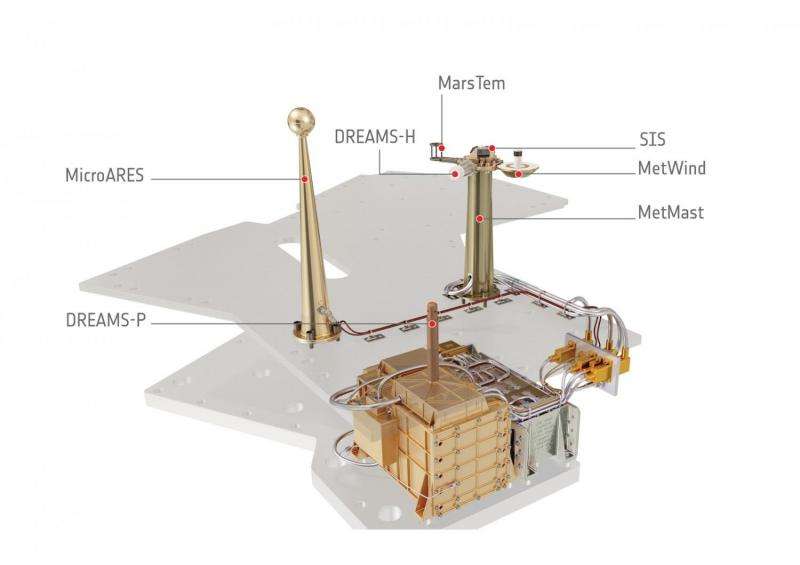Europe's ExoMars mission arrives in the middle of dust season

The joint ESA-Roscosmos ExoMars 2016 mission is knocking on the Martian door to answer important astrobiological questions. While the mission's Schiaparelli module will focus on testing landing technologies, one of its scientific instruments will be in just the right place at the right time to investigate the planet's intense dust storms.
The ExoMars 2016 mission consists of two spacecraft: the Trace Gas Orbiter (TGO) that will search for evidence of methane and other trace atmospheric gases, and the Schiaparelli lander, an entry, descent and landing demonstrator module. On Oct. 16, the lander will separate from TGO, entering the atmosphere for a six-minute descent, landing in Meridiani Planum on Oct. 19.
While TGO will commence its science mission at the end of 2017 following a year of complex aerobraking maneuvers to circularize its orbit, Schiaparelli is expected to be on duty immediately after entry into Mars' atmosphere, collecting crucial data during controlled descent and landing.
After landing, Schiaparelli will activate its Dust Characterisation, Risk Assessment, and Environment Analyser on the Martian Surface (DREAMS) system, which could provide important insights on the nature of intense dust storms occurring periodically on Mars.
"After landing, we will operate the DREAMS environmental station," Jorge L. Vago, ExoMars Project Scientist at ESA, told Astrowatch.net. "One objective of DREAMS is to measure for the first time the large electric fields that get generated due to friction between dust grains in the Martian atmosphere—the same happens in the Sahara on Earth."

The DREAMS station includes a set of sensors designed to measure the wind speed and direction (MetWind), humidity (DREAMS-H), pressure (DREAMS-P), atmospheric temperature close to the surface (MarsTem), the transparency of the atmosphere (Solar Irradiance Sensor, SIS), as well as atmospheric electrification (Atmospheric Radiation and Electricity Sensor; MicroARES).
In general, ExoMars scientists hope that DREAMS will provide measurements of the concentration of atmospheric dust, which could yield new results regarding the role of electric forces on dust lifting, the trigger for dust storms.
Martian storms could be very powerful when Mars reaches its perihelion as the sunlight striking the planet will be 20 percent more intense than the annual average. While planet-wide dust storms on Mars are difficult to predict exactly, scientists forecast severe dusty events in late October 2016 when the Red Planet will be at its closest point to the sun, which coincides with Schiaparelli's arrival.
"Now is the dust storm season, the time of the Martian year when the atmospheric dust content is highest. We may even encounter a dust storm, which would be great for science," Vago said.
One week ahead of the landing, Schiaparelli is currently in excellent health. In early October, the teams uploaded the last bits of software, prior to the planned separation of the module from TGO. They also conducted simulations on the ground using the Avionic Test Bench (ATB) to prepare the operations group for post-Mars Orbit Insertion (MOI) activities.
Source: Astrowatch.net





















